Rotten‘Zine
Rotten‘Zine a division of The Rot Doctor, Inc. All rights reserved.
Table of Contents
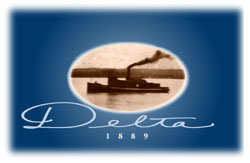
DELTA’s Story: Where She Came From and How She Survived
by Dr. Rot

In many ways, DELTA’s story is a familiar one to connoisseurs of old wooden boats. She went through all the usual permutations. What’s not so usual is that she has survived as long as she has and the extraordinary amount of documentation that accompanies her. Both her survival and the documentation are the result of a chance meeting between DELTA and two Canadians, one still alive and the other one dead.  Let’s begin with that meeting and then work backward and forward from there. It’s an interesting story and a testament to the Quixotic and romantic nature of some humans. It represents some of the best our species has to offer.
Let’s begin with that meeting and then work backward and forward from there. It’s an interesting story and a testament to the Quixotic and romantic nature of some humans. It represents some of the best our species has to offer.


Jim Chidley was the man and Gayle Champion, who would one day be his wife, was the woman. In 1980 Chidley, who was a trucker until a series of heart attacks stripped him of his ability to work and he had to take up apartment management, was hauling a friend’s boat out of the Fraser River,  east of Vancouver, British Columbia. It was night with a low moon, and he saw a hull sticking out of the mud, silhouetted against the moonlight. That was the beginning. We’ll let the man speak for himself (as quoted by the Vancouver Sun, June 17th, 1986):
east of Vancouver, British Columbia. It was night with a low moon, and he saw a hull sticking out of the mud, silhouetted against the moonlight. That was the beginning. We’ll let the man speak for himself (as quoted by the Vancouver Sun, June 17th, 1986):
“I stumbled across it in the dark. It was full of water, and it was covered with a green growth. She was derelict and ugly, an old workhorse. Tugboats are taken for granted. They’re like dump trucks: strong and reliable… She was just kind of sitting there. She had obviously been used as a live-aboard, but not lately. The name meant nothing to me.”
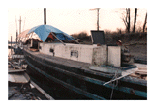 Inside he found a scrap of paper stuck to a bulkhead with a phone number scribbled on it. Chidley eventually tracked down the owner and bought the boat for $5,500. She was 50′ long and 12′ on the beam and had a diesel engine that Chidley eventually got to run.
Inside he found a scrap of paper stuck to a bulkhead with a phone number scribbled on it. Chidley eventually tracked down the owner and bought the boat for $5,500. She was 50′ long and 12′ on the beam and had a diesel engine that Chidley eventually got to run.
So it began. At this time Chidley knew nothing of the boat’s history. He and Gayle were looking for something they could rebuild and get out cruising. With the engine running, they moved her to a nearby boat yard. 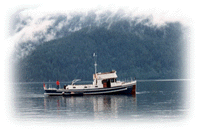 There they found that the oak framing and 2″ fir planks were in generally good condition, but everything else had to be replaced. A wheelhouse and cabin were installed, and a fly bridge on top of the cabin. She was re-plumbed and rewired and $16,000 worth of electronics put aboard. Jim and Gayle cruised her around British Columbia. People saw the boat and a few old timers remembered her ‘back when’, particularly 82 year old William Benneck, who had received his master’s papers aboard DELTA in 1921; inklings of her history began to emerge.
There they found that the oak framing and 2″ fir planks were in generally good condition, but everything else had to be replaced. A wheelhouse and cabin were installed, and a fly bridge on top of the cabin. She was re-plumbed and rewired and $16,000 worth of electronics put aboard. Jim and Gayle cruised her around British Columbia. People saw the boat and a few old timers remembered her ‘back when’, particularly 82 year old William Benneck, who had received his master’s papers aboard DELTA in 1921; inklings of her history began to emerge.

On December 2nd, 1982 there was disaster. . .
Chidley had left the diesel cook stove on to keep the boat warm. The carburetor flooded and burning diesel fuel spilled into the cabin. No one was aboard. Chidley recalls: “I was up here at the shipyard paying my bill while the boat was burning. I was on my way home and passed the fire trucks going to my boat. I didn’t know where they were heading.” Damage was restricted to the superstructure but was extensive. The boat was insured for $25,000 and the insurance surveyor estimated that $60–70,000 would be required to rebuild her. Chidley estimated about $40,000 would do it, and bought the hull back from the insurance company for $1,000 and got a demand note for $24,000 from their bank based on the soon-to-be-issued insurance check. The boat was taken to Admiral Shipyards.
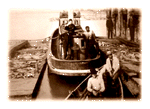
Meanwhile, DELTA’s full history was slowly emerging, orally from people who remembered or knew someone who remembered and through the research efforts of Jim and Gayle. People seem to like to talk about the past and old things, even as the main thrust of our society rushes into the future in almost total disregard of history. And boats in particular…that atavistic connection between humans and the sea. Or just the comfort of known things, an understood continuity.
Here are excerpts from a report by Robert L. Sperling prepared in 1989 for the Heritage Conservation Branch of the Canadian Ministry of Municipal Affairs, Recreation and Culture in preparation for the celebration of DELTA’s 100 year birthday:
“The DELTA was built as a cannery tugboat in 1889 at Victoria, B.C. by William Turpel at Central Shipyard for James A Laidlaw. Her engine and boiler were built by the Albion Iron Works, Victoria, B.C., so she was truly a British Columbia product, as opposed the some vessels whose hulls and superstructure were built of British Columbia products, but whose boilers and engines were imported from Eastern Canada or Scotland.
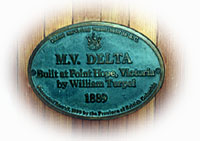
“The DELTA was launched on Saturday, May 18, 1889, as reported by three Victoria papers, at Clark and Turpel’s ways, on Point Hope, in Victoria’s Upper Harbor.... The hull was then taken across the harbor to Spratt’s wharf, where her boiler and engine were installed. On June 8, 1889, the DELTA made a trial trip and achieved a speed of ten knots.
“On June 19, 1889 the DELTA steamed out of Victoria Harbor, on her way to New Westminster, B.C. to take up her duties as a cannery tugboat for Mr Laidlaw’s Delta Canning Company, on the Fraser River. She was considered ‘beautiful’, ‘staunch’, and ‘the fastest boat of her size in British Columbia’s waters’, by journalists reporting her arrival on the Fraser River. One reporter said, ‘She steamed out of Victoria Harbor like a scared wolf’.
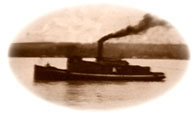
“In the fishing season the DELTA’s duties would include transporting personnel to man the cannery, hauling tinplate for making cans, hauling box shooks for making boxes to hold the cans, hauling fresh fish from the fishing grounds to the cannery, towing the engineless fishing boats to and from the grounds, hauling wood fuel for the cannery boilers, hauling fish remains to the glue factory, and transporting cannery officials. She also spent time searching for missing boats in storms and in rescuing their crews. In 1889 the Delta Canning Company was allotted twenty-four fishboats for the DELTA to look after.
“In the off-season, the DELTA was put to work in general towing, handling tows of coal, log towing, delivering produce from farms, towing gravel, and towing mud from dredges.
“In 1906 the DELTA was purchased by a lumberman and went into the log towing business. She continued this occupation until the mid-1920’s when she was converted into a fishboat, packing fish and later trolling for salmon.
“In 1978, after proving herself a fast boat and a good sea boat, and a productive member of the fishing fleet, the DELTA was sold out of the fishing fleet in the Federal Government's buy-back programme. By January, 1980, after having served as a live-aboard vessel, she had become an abandoned hulk on the Fraser River.”
Those are the bare bones of her history. Notes and scraps of paper and ship’s log fill in some of the human details:
“I bought boat from Bill White [for] $1M. Used to be berthed around First bridge of Fraser River. When purchased it had a 3 cylinder Deutz Diesel. But Frank Gray my brother-in-law said he wanted to take [the] Diesel out and substitute with Big 6 Studebaker Car engine. He made a deal with old man Scott who had a type of marina (Mitchell Island) etc., fixed old engines etc. for an even trade. I was not too happy about this because I had to buy a 2-1 Simplex marine clutch. I remember going to Simplex people and paying them. So that’s how the engine was installed. I later sold the Boat to a Dan Cambell who said he was going to convert to tuna fishing. After that I can’t remember what happened later on. [Signed] Frank Frazer.”
A log from 1962 to 1966 shows that DELTA was owned by a T. Wise, who, we learn from other documents, was also a part-time photographer for the National Geographic magazine. One thing is certain, he was no writer; the log is little more than terse comments on weather and wind direction and what cove 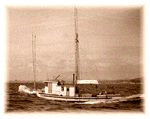 he holed up in overnight. Receipts from British Columbia Packers Limited show that Mr. Wise was catching mostly what were called “Red Spring” and “Cohoe” for which he was paid anywhere from $0.66 to $0.31 a pound, depending on size and condition.
he holed up in overnight. Receipts from British Columbia Packers Limited show that Mr. Wise was catching mostly what were called “Red Spring” and “Cohoe” for which he was paid anywhere from $0.66 to $0.31 a pound, depending on size and condition.
From an article in February 26, 1970 Free Press we know that DELTA was then owned by a George Webb.
“Old boats, like some people, lead long and hazardous lives. The DELTA has probably outlived all the skippers who sailed her up and down the coast for nearly a century....Mr Webb said that fellow who knew most about the boat, Carl Mostad, of Port Alberni, died last year and information about her is pretty sketchy. ‘It’s a real good sea boat’, he said. ‘And because it’s so narrow, it’s fairly fast.’...‘I believe it was originally built with dowel construction.’ That is, the planks were fastened to the ribs with wooden pegs.”
I can tell you that Mr. Webb was wrong about the pegs; DELTA was originally fastened with 5″ black iron square nails. Which gets us back to Jim Chidley and Gayle Champion and a burned-out DELTA on the ways at Admiral Shipyards.
The wheelhouse and most of the decks were chain-sawed off and more than 100 ribs were sistered in, the top plank replaced and new shear clamps added. Shipwright Ed Wahl designed and installed a new, larger wheelhouse and cabin based on an old photograph of DELTA. Then the insurance company declared bankruptcy. The bank wanted their money back. Admiral Shipyard put a lien on the boat, which in turn forced the bank to give Chidley a mortgage on the vessel. At this time interest rates were running 17 percent and so Jim and Gayle were burdened by a boat and house mortgage at prime rate. They did what any romantic fools would do: They sold the house and put the proceeds into DELTA.
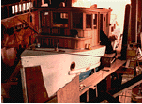
On November 25th, 1983 Admiral Shipyards issued a Statement of Account to Chidley and page after page of supplies and their cost. The statement shows that up to that point $53,243.35 had been spent, $36,000 had been paid, and $17,243.35 was outstanding. Labor to that point was listed at 696 hours @ $35.00/hr; the rest was materials. Amongst the nails, screws, sandpaper, glue, carriage bolts, nuts, washers, Cuprinol, Paraseal, cotton, red lead, insulation, asbestos, hose, pipe, linseed oil and so forth, there are 30 board feet of 5″ red cedar for $64.80, 250 feet of “bending oak” @ $2.50 bd. ft., 270 board feet of yellow cedar for $405.00, 258 board feet of #1 fir for $186.00, 80 board feet of edge grain fir for $120.00, 24 board feet of gumwood for $60.00, more red cedar, more oak, more gumwood, and so forth. Just reading it gives me the shakes. I can feel the terror that the relentless momentum of major boat yard work creates.
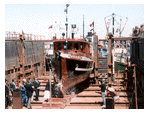
Five months after going on the ways, DELTA was re-launched. I don’t know what the final bill was. Gayle claims $200,000 was put into DELTA altogether, but I imagine that includes the original reconstruction and 2 sets of fittings and electronic equipment. In any event, it’s a lot of money to put into a boat that was now nearing her 100th birthday.
Jim Chidley and Gayle Champion had by this time decided to exploit DELTA’s heritage to it fullest. Like most human endeavors, the motives were mixed: On the one hand they were truly in love with the old vessel and her past and wanted to make her available to the public; and on the other hand I’m certain they had an eye on her heritage value and the possibility of someday recapturing their investment. The main idea was to get her exhibited in Canada’s Expo ‘86, which was to be held in Vancouver on the water and which would have a historical marine exhibit. They continued to research her past and at the same time write letters appealing for help and to get the boat mentioned in the British Columbia newspapers and marine press. The response was not encouraging. Expo ‘86 officials did not appear particularly interested.
And then early in 1985, another kind of disaster. A series of five heart attacks put Jim Chidley in the hospital and on life-support. Doctors told him that he could not survive, his heart was damaged beyond their ability to repair it. His only hope was to go to Ontario and wait and hope for a transplant. Chidley was not yet fifty years old and was thus a good candidate. In May, 1985 he received the heart from an 18 year old and was back in Vancouver. He was, of course, unemployable, and so he devoted himself full time to DELTA.
Timing is everything, and just 100 days before Expo ‘86 was to open an article in the Vancouver Sun detailing the history of DELTA and Chidley brought in offers of volunteer work, some corporate donations and an invitation from Expo officials to exhibit the boat in the water as a part of British Columbia maritime history. However, they wrote, she must be “in full show condition”. And so she was. Jim and Gayle decided to put forth a major marketing effort. Along with the boat when we purchased it came a box containing DELTA refrigerator magnets, small laminated full color pictures of her with a clip (for hanging on your lapel?), a roll of wine labels, bumper stickers, and what-not. Pictures taken at the time show DELTA shining with new paint and varnish. We visited Expo ‘86, one of the best ever of the world’s fair series and a credit to British Columbia, but don’t remember DELTA. Our eyes must have seen her but I believe we were most likely still recovering from the traumas of our last old wood boat.
We can jump now to 1988. An Expo veteran and star attraction in old boat shows, DELTA was receiving plenty of press. A newspaper article in The Province outlines Chidley’s plans:
“Now she’s going on display again, the star of the wooden boat show at the Sea Festival. But her place in the nautical firmament isn’t fixed yet.
“‘There's still work to be done,’ says Chidley, 49, who would like a steam engine to replace her modern diesel.
“Next year, DELTA will be a century old, the first boat in BC to reach that august age. To mark the event, the Victoria shipyard where DELTA was built in 1889, the Ministry of Tourism and several unions will work together on a rechristening.
“Purchase from an American company is looking better and better. But, says Chidley, ‘I’m not looking for money, just help, corporate sponsorship.'”
Reading this, I can’t imagine which American company might have had any interest in this old boat nor why, but it was the first of a series of threats to come about selling out to Americans. I also have to wonder where on DELTA Chidley thought he would put a steam engine; he and Gayle were living on board and I don’t believe there are any steam engines around that would have fit in the space under the wheelhouse. But then we know by now that Chidley was more a romantic than practical man.
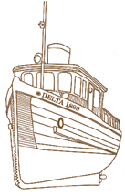
DELTA did have her Centennial celebration, and it was a grand event. We have many pictures taken at the time, newspaper clippings, and a professionally produced video (sort of a Canadian version of Charles Kuralt’s series on some of the more arcane bits of Americana) showing bag pipers, costumed dancers, model boat building contests for the kiddies, various dignitaries wandering around, journalists, marine historians, an assemblage of Canadian tugs (working and vintage), and the re-christening itself. DELTA herself looked spiffy; the outside of the boat had been completely refinished by volunteer labor from local 1 of the Marine Maintenance Union, Point Hope Shipyard.
In 1993 Jim Chidley died. Gayle Chidley (they had married just after Jim’s heart transplant) put the boat up for sale, $200,000 asking. At the same time the Cowichan Bay Maritime Center of Duncan, B.C. was attempting to secure corporate sponsorship to purchase the heritage vessel. For those of you who have followed the efforts of various groups in the United States to get corporate or government funding for the preservation of historic vessels, you know that the prospects are grim. It rarely happens. We live in a future-oriented, dollar worshiping culture. “History is bunk!”, Henry Ford said.
Gayle stayed in touch with the press. A September, 1993 Vancouver Sun, the same paper that jump-started the action in 1986, article reported:
“Unless the owner of the oldest boat built in B.C. finds a local buyer, part of the province’s maritime history may soon be chugging south to the United States
“So far only Americans in Washington state and California have shown any interest in buying the tug, built in Victoria in 1889.
“‘I am really, really frustrated because I can’t get anyone here interested in it,’ Chidley said.
“‘I know that once it gets out that it is being sold to Americans, everyone will scream and yell. I need to give B.C. a wake up call.’
“She said the DELTA is worth $200,000 but she would sell it for half that amount if she ensures it stays in B.C.”
By January of 1995 nothing had happened. A local Seattle boating magazine, Nor‘Westing picked up the DELTA story and ran a feature story. “I don’t want to walk away from [DELTA]”, Gayle explains, “but I need to get back to a more normal life-style. It’s time to get on with the next chapter of my life.” The price had dropped to $55,000 Canadian.
And then we came along.
Gayle Chidley is a woman of great personal dignity and strength. When we first met her in February of 1995 she made us generally aware of DELTA’s history, but spoke little of the travails she personally had been through. DELTA herself was looking a bit shopworn; nothing much in the way of exterior maintenance had been done to her since her 100th birthday. I climbed into and examined all accessible interior hull spaces. I could tell by the smell that if she had rot it wasn’t massive, and I didn’t find much; the top of the horn timber was the most evident. Outside there was some more soft wood on the decks forward, some rot in the bulwarks port side aft and that was about it.
We paid Gayle what she asked, which worked out to $38,000 U.S., and although she was sorry to see the boat leave Canada, I believe she liked us personally and felt that DELTA was passing into caring hands. If anyone in Canada screamed and yelled when she sailed south, we didn't hear about it. Gayle was clearly happy to be relieved of the burden and I could understand that perfectly, although my parting with former wooden loves had never trailed such a history of personal commitment and heartache.
DELTA’s survival today is due entirely to Jim and Gayle Chidley. Few other people in this world would have gone through what they did to bring her back. Surely Jim sits in a place of honor among the spirits of all those who had owned, worked and loved this old boat…and there are many, all gone now.

Beyond this, it was good wood and cold water, what she was made of and what she lived in. When we pulled planks in the bow, port and starboard, the keel timber was exposed and was so pickled by time, salt, and minerals that you could hardly get the point of a sharp knife into the wood. It was semi-petrified. The 5″ iron nails were hand forged. There were some deteriorated frames and they were sistered as far up as we could afford to go. The rot in the horn timber was found to not be as extensive as it might have been and has been removed and replaced with epoxy resin and glass tape. Heresy for shipwrights and traditionalists, but as a practical matter all we could afford to do.

DELTA is looking better now, pockets of rot removed, new paint and her brightwork brought back. She had better look good, because she’s about to be exploited once again, this time as the research laboratory for Rot Doctor products. She was built as a workboat and meant to work and she has… one way or the other. Her survival depends on it.
As for us, we like her well enough and honor her past and the ghosts of those who were there before us, but it’s yet too early in the relationship to call it love.
